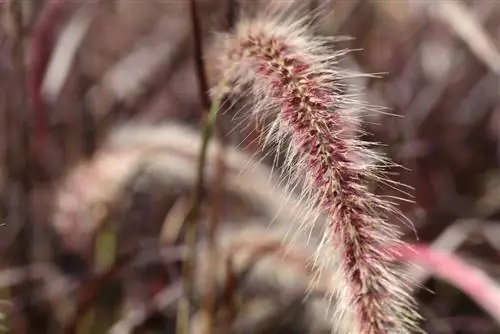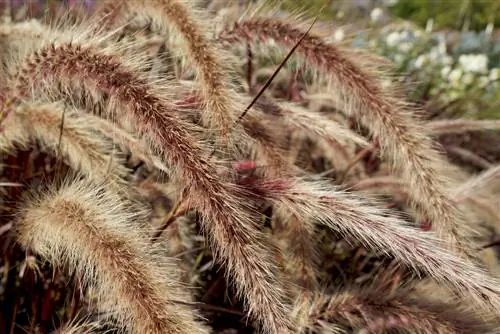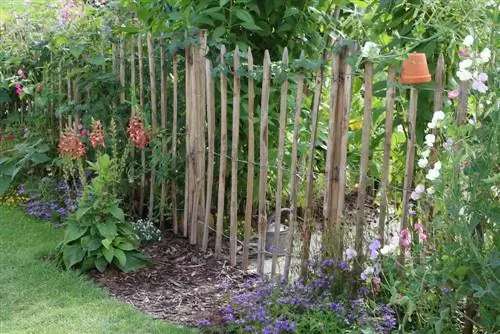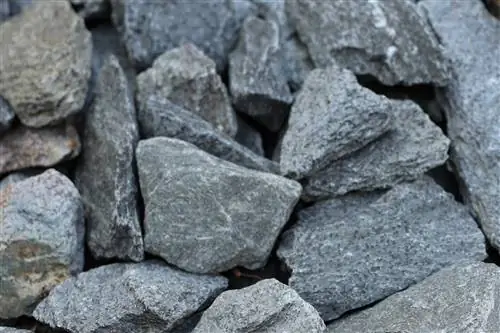- Author admin [email protected].
- Public 2023-12-17 03:39.
- Last modified 2025-06-01 06:48.
Do you value ornamental grass because of its decorative appearance and durability? Pennisetum grass (Pennisetum alopecuroides) is an ornament for flower beds and a good companion for roses, for example.
Appearance and cultivation forms of Pennisetum grass
The Pennisetum grass grows in typical clumps. Depending on the location and variety, the stalks of the plant reach a height of between 10 cm and 120 cm. The leaves are narrow (up to 1 cm) and long (up to approx. 80 cm). The color of the stalks and leaves varies between medium and dark green or even purple. This plant stands out primarily for its attractive inflorescences, which are called false spikes because of their appearance. The spikelets (partial inflorescences) are yellowish green to dark purple. The grass blooms from mid-July to the end of October and looks attractive even after the flowering period. Some cultivated forms of Pennisetum grass are known, e.g. “Hameln” with brown-red false spikes or the dwarf Pennisetum grass “Little Bunny”, whose stalks are between 10 cm and 30 cm tall.
Pennisetum location
Like all grasses, this plant also loves sunny locations. It does not tolerate shade well and quickly withers away. A good location for the Pennisetum grass is the sunny south side of the house. The grass looks good at the edge of a garden path or in a flower bed. The plant does not tolerate waterlogging particularly well, but the grass also does not like soil that is too dry. Ideally the ground should be loose, as is the case with a bed. Pennisetum grass can be used as a container plant and looks convincing on a terrace or balcony.
Fertilize and water Pennisetum grass
After purchase, the clump can be easily divided (preferably by hand), each plant grows quickly and forms a new clump. Since Pennisetum grass is one of the rather undemanding plant species, it is happy with pre-fertilized potting soil or compost soil, at least in the first few months after planting. Afterwards, around two to three months after planting, regular fertilization with products for green plants can be started. It is advisable to apply the fertilizer diluted, because the pennisetum reacts to over-fertilization with yellow leaves and poor growth. This circumstance particularly affects potted plants. When watering pennisetum grass, it should be noted that potted plants need regular water supply; the grass in the garden should only be watered as needed. Watering as needed means: Only when the summer is dry and hot. Evening hours are the best time of day for watering.
Care for Pennisetum Grass in Summer
Caring for Pennisetum grass includes, above all, observing the most important rules:
- Avoid waterlogging
- Fertilize regularly, but not excessively
- Make sure the plant gets enough sun
If many yellow leaves and stalks can be seen, it should be understood as an alarm signal. This can be a sign of soil that is too moist and too dense, as well as a sign of excessive dryness. A small proportion of yellowed leaves is a natural phenomenon. For a better look, these parts should be removed with secateurs.
Protection against pests and frost damage
This type of grass is one of the less sensitive representatives of the flora. Rust fungal infestation poses a danger to the plant. This disease can be recognized by rust-brown spots that cover leaves. As a remedy, commercially available fungicides are recommended.

Most of the grasses offered by nurseries are hardy, but that doesn't mean that Pennisetum grass doesn't need winter protection. In particular, clumps of grass and potted plants growing unprotected are in need of protection. From the first frosty days, it is worth covering the grass with spruce branches or with special fleece. Potted plants should best overwinter in wind-protected locations, but outside they still need one or two layers of fleece, which should also cover the pot itself. A good way to get the Pennisetum grass in a pot through the winter is to place it in an unheated but frost-free winter garden.
Spring pruning and propagation of Pennisetum grass
This type of grass, like most other grasses, is cut back in spring. The Pennisetum grass can be cut as early as April. It is enough to leave only about 10 cm of the blades of grass (for short-growing varieties it can even be 5 cm). Cutting back gives space for the new shoots so that the plant develops well and remains he althy. Fertilizing is particularly helpful after pruning. Pennisetum grass can be propagated without much effort. The optimal time for this is also in spring (April - May). The plant is removed and carefully divided with your hands. This makes it easy to turn one nest into three or four.
What you need to know about Pennisetum grass
- robust and undemanding plant
- depending on the variety between 10 and 120 cm high
- very decorative in flower beds
- needs a sunny location
- should be watered moderately, but must not dry out
- needs pre-fertilized potting soil and then fertilizer for green plants to thrive
- conditionally hardy, needs protection
- the ideal time for cutting is spring
- can be propagated simply by sharing
A mix of perennials and grasses is particularly beautiful for the garden. Here you can use the pennisetum grass very well. This places virtually no demands on the soil, but prefers a sunny spot. With a height of 60 to 120 cm, the Pennisetum is one of the taller grasses in the garden - and it can bloom! The flowering period is between July/August and September/October, depending on weather conditions. The flowers of the Pennisetum grass range in color from silver-brown to reddish. The grass naturally flowers in winter, but the perennial is quite winter hardy. However, to protect them from excessive frost, you should install moisture protection. The undemanding plant only requires that it be tied together somewhat. Covering the ground with leaves can also be helpful.
Conclusion
Pennisetum grass is an effective plant for every garden. Caring for this herbaceous plant is easy and is mainly limited to moderate watering and fertilizing. This grass needs winter protection, but can overwinter outdoors. Propagating Pennisetum grass is uncomplicated. You should think about pruning in the spring.






